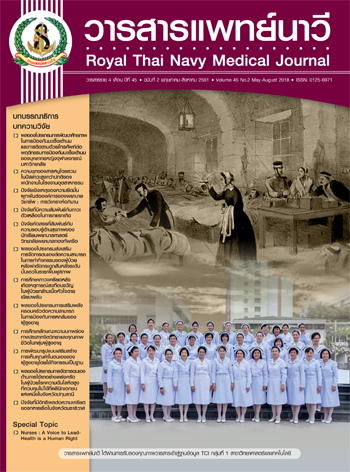A Study of Post-Traumatic Stress in Patients after Acute Myocardial Infarction
Main Article Content
Abstract
The objective of this study was to determine the relationship between sociodemographic of patients, anxiety, helplessness, and post-traumatic stress symptoms 1 - 3 months after Myocardial Infarction (MI). One hundred twenty six patients were recruited using multistage sampling technique. The assessments included sociodemographic questions, Spielberger State Anxiety Inventory, The Learned Helplessness Scale (LHS), and The Posttraumatic checklists specific version (PCL–S). Cronbach’s alpha for reliability were 0.76, 0.96 and 0.88, respectively. Statistical analysis included Chi-square test, Anova and Biserial correlation coefficient. The study found that 32 patients (25.40%) reported post-traumatic stress symptoms (X = 28.03, SD = 9.79). Income level, child status, further treatments and multimorbidity were significantly related to post-traumatic stress symptoms at level of .05. Anxiety and helplessness were significantly related to post-traumatic stress symptoms at level of .05 (r = 0.20, and 0.33).
Article Details

This work is licensed under a Creative Commons Attribution-NonCommercial-NoDerivatives 4.0 International License.
References
สมาคมแพทย์โรคหัวใจแห่งประเทศไทยในพระบรมราชูปถัมภ์. แนวทางเวชปฏิบัติในการดูแลผู้ป่วยโรคหัวใจขาดเลือดในประเทศไทย ฉบับปรับปรุงปี 2557. กรุงเทพมหานคร: ศรีเมืองการพิมพ์; 2557
Wattanakitkrileart D. Psychosocial problems in patients with heart and lung disease and nursing care. J Nurs Sci 2009;27(2):22-31. (in Thai)
Bennette P, Owen RL, Koutsakis S, Bisson J. Personality, social cortex and cognitive predictor of posttraumatic stress in myocardial infarction patients. Psychology and Health 2002;17(4):489-500
Alonzo AA. The experience of chronic illness and post-traumatic stress disorder: the consequence of comulative adversity. Soc Sci Med 2000;50(10):1475-84
Pedersen SS, Middel B, Larsen ML. Posttraumatic stress in first-time myocardial infarction patients. Heart Lung 2003;32(5):300-7
Tulloch H, Greenman PS, Tassé V. Post-traumatic stress disorder among cardiac patients: prevalence, risk factors, and considerations for assessment and treatment. Behav Sci (Basel) 2014;5(1):27-40
Shemesh E, Yehuda R, Milo O, Dinur I, Rudnick A, Vered Z, et al. Posttraumatic stress, nonadherence, and adverse outcome in survivors of a myocardial infarction. Psychosom Med 2004;66(4):521-6
Wood SL, Froelicher ES, Motzer SU, Bridges EJ. Cardiac nursing. China: Wolters Kluwer Health Lippincott Willium and Wilkins; 2010
Ehlers A, Clark DM. A cognitive model of posttraumatic stress disorder. Behav Res Ther 2000;38(4):319-45
Mesuwun P, Naka K. Perception of severity of the illness, information required, and anxiety among preoperative ENT patients in Songklanagarind Hospital. Songkla Med J 2008;26(2):185-93. (in Thai)
Quinless FW, Nelson MA. Development and measurement of learn helplessness scale. Nurs Res 1988;37(1):11-5
National Center for PTSD. Using the PTSD checklist (PCL). [Internet]. [cited 2015 April 18]. Available from: https://sph.umd.edu/sites/default/files/files/PTSDChecklistScoring.pdf
Malinauskaite I, Slapikas R, Courvoisir D, Mach F, Gencer B. The fear of dying andm occurrence of posttraumatic stress symptoms after an acute coronary syndrome: A prospective observational study. J Health Psychol 2015:1-10
Wiedemar L, Schmid J-P, Müller J, Wittmann L, Schnyder U, Saner H, et al. Prevalence and predictors of posttraumatic stress disorder in patients with acute myocardial infarction. Heart and Lung 2008;37(2):113-21
Castilla C, Vazquez C. Stress-related symptoms and positive emotion after myocardial infarction: a longitudinal study. European Journal of Psychotraumatology 2:1, 8082, DOI: 103402/ejptv2i08082 2011
van Driel RC, den Velde WO. Myocardial infarction and post-traumatic stress disorder. J Trauma Stress 1995;8(1):151-9
Trotter R, Gallagher R, Donoghue J. Anxiety in patients undergoing percutaneous coronary interventions. Heart Lung 2011;40(3):185-92
Warlan H, Howland L. Posttraumatic stress syndrome associated with stays in the Intensive Care Unit: importance of nurses’ involvement. Crit Care Nurse 2015;35(3):44-52
Atik D, Neşe A, Çakır M, Ünal A, Yüce UÖ. Post traumatic stress and anxiety in patients with acute coronary syndrome. International Journal of Research in Medical Sciences 2015;3(8):1778-884
Deftereos S, Giannopoulos G, Raisakis K, Hahalis G, Kaoukis A, Kossyvakis C, et al. Moderate procedural sedation and opioid analgesia during transradial coronary interventions to prevent spasm: a prospective randomized study. JACC 2013;6(3):267-73
Krauseneck T, Padberg F, Roozendaal B, Grathwohl M, Weis F, Hfmann D, et al. A β-adrenergic antagonist reduces traumatic memories and PTSD symptoms in female but not in male patients after cardiac surgery. Psychol Med 2010;40(5):861-9.
Jerlock M, Gaston-Johansson F, Danielson E. Living with unexplained chest pain. J Clin Nurs 2005;14(8):956-64
Maier SF, Seligman ME. Learned helplessness: theory and evidence. Experimental psychology 1976;105(1):3-46
Johansson A, Dahlberg K, Ekebergh M. Living with experiences following a myocardial infarction. Eur J Cardiovasc Nurs 2003;2(3):229-36
Smallheer BA. Learned helplessness and depressive symptom in patients following acute myocardial infarction. Nashville, Tennessee: the Faculty of the Graduate School of Vanderbilt University; 2011


